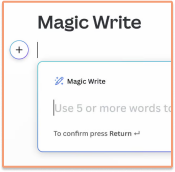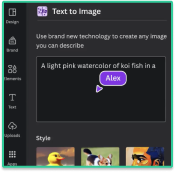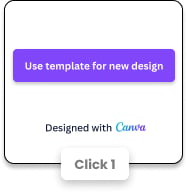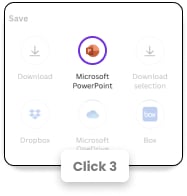If you’ve watched Jurassic Park — or spoken to any child about dinosaurs for more than 10 seconds — you’re probably aware that a T-Rex’s vision is based entirely on movement.
If you don’t move, they can’t see you.
A similar rule applies to presentation design. A little bit like a T-Rex, our human eyes are also drawn towards movement. So using animated elements in your slides is a great way to grab — and hold — your audience’s attention.
And the most successful presentations in history prove this to be true.
Videos have been used in presentations as far back as 1984, when Steve Jobs unveiled the new Macintosh computer. Steve used video (played on a Macintosh, of course), to showcase the computer’s various capabilities.
To this day, video remains a fantastic way to keep your viewers engaged. But there’s something that Steve didn’t have back in 1984 — and we bet he wishes he did.
GIFs are another fantastic way to animate your presentation. While they are much shorter than videos, and are not intended to convey information, GIFs are a good way to provoke a certain reaction in your audience.
Both videos and GIFs can add a great deal to any presentation — as long as they’re used sparingly and in the right context. In this guide we’ll explore the most impactful ways of using videos and GIFs in presentations, as well as some common pitfalls you should avoid.
- How to use GIFs in your presentation
- How to use videos in your presentation
- Deciding between GIFs and videos — what’s right for your next presentation?
How to use GIFs in your presentation
Did you know that the GIF (Graphics Interchange Format) is over 30 years old?
It has varied in popularity over the years, and has not always enjoyed the level of fame it holds across social media and branded comms today.
These days, the most popular GIFs use a brief piece of footage of a well-known person, a famous film, or an otherwise forgettable home movie — taken out of context and looped.
GIFs are great because they are both funny and relatable. Some of the most well-known GIFs of all time include former President Barack Obama’s famous mic drop, Rick Astley (from the dreaded “Rick roll” prank) and the all-time classic that is “dramatic reaction chipmunk”.

Whatever the situation, there’s a GIF to match. And if you use them wisely, they can really make your presentation stand out.
But are they suitable for every presentation?
Simply put — no. You probably don’t want to use a GIF if you are presenting to potential investors (unless you know they share that sense of humor). And you certainly don’t want to use them if you’re sharing a medical report or academic paper.
But, for some presentations, GIFs offer a few advantages over videos.
Most importantly, they’re easy to use. GIFs loop automatically, so you don’t need to worry about finding the ‘play’ button or messing up the timing of your delivery.
They also don’t make any sound, meaning you can talk over them — though you may want to pause for laughter if you have used a particularly comedic GIF.
Finally, their file sizes are tiny compared to video, making them much easier to share and embed.
While they don’t suit a highly professional situation, there are many cases where a GIF would fit into your presentation very nicely. To help you make the most impact with GIFs, here are some dos and don’ts that you should follow:
Do:

Use a GIF to show humor
Laughter makes everything easier.
Whether you need to soften a point or simply build rapport with your audience, a well-placed GIF can elicit a laugh from even the toughest crowd and help put everyone, including you, at ease.
Use a GIF to illustrate a point or highlight an idea
You might be trying to convey how frustrating a problem is, how excited your customers are about your product, or the worrying implications of not taking action on something — a GIF is worth a thousand words when it comes to helping your audience empathize.
Use a GIF as a background to make your slide more eye-catching
This is a tough one to pull off, as you don’t want the GIF to detract too much attention. So think simple. There are lots of looping landscape or geometric pattern GIFs that could really help to focus your audience’s attention on a slide — and hold it there while you discuss the contents.
Use a GIF to introduce a new topic or section
The introduction of a new topic or section is a chance for your audience to catch their breath and collect their thoughts. Including a GIF can help bookend your sections with a little humor and keep your audience relaxed and engaged.
So that’s how you use GIFs in the right way.
But what shouldn’t you do?
Don’t:
Use GIFs when you want to be taken seriously
GIFs are not suitable for every situation and if you want to be taken seriously, it might be better to avoid them altogether.
Fill a slide with GIFs
The only thing this will achieve is confusing and distracting your audience.
Add a GIF to every single slide
Like salt when you’re cooking, a little sprinkle is usually enough. Overusing GIFs is a great way to wear off the novelty fast — and will make your presentation feel needlessly bloated.
If you want to find some GIFs to add to your presentation then head over to one of the major sites like Giphy or Tenor and start your search.
But if you think that a GIF might be a little too cute, or you want to mix things up in a more professional presentation, incorporating video might be the way to go.
How to use videos in your presentation
Think back to that video of Steve Jobs in 1984.
What was revolutionary back then is still seen as a bit ‘out there’ today. Only around 4% of professionals include video elements in every presentation they do. Are they the crazy ones, or are the rest of us missing a trick?
Studies have shown that when people are exposed to multiple types of media during a learning process, they recall information much more clearly and accurately. Creating a multi-sensory environment around your presentation is a sure-fire way to keep your audience’s attention focused on you like a laser.
GIFs have their place, but videos offer great benefits too. They’re a fantastic way to tell short, impactful stories and to provoke strong emotional responses in your audience.
Videos can also help you to communicate a lot of information quickly and simply. Combine this with the added advantage of helping your audience to remember this information more effectively, and video offers a double whammy of benefits.
Using video in your presentation will keep your message resonating with your audience long after you have packed up your laptop. To get the most out of this type of animation, here are some more dos and don’ts for you to remember:
Do:
Keep your videos short (30-60 seconds)
Any longer than 60 seconds and you’ll begin to lose your audience’s attention — which means you’re also losing all the benefits of including video in the first place!
Favor casual, authentic, and realistic videos
To build rapport and a personal connection with your audience, steer clear of overly stylized or stuffy corporate videos. Instead, choose something authentic that will stir an emotional response.
Choose your videos purposefully
Any video you include should be highly relevant to the contents of your slides. If it’s not, you risk coming across as gimmicky.
Use videos to break up monotony
If you reach a particularly dense section of your presentation, follow it with a video. This could illustrate a real-world example of your point, or communicate the benefits of what you have just discussed. Either way, it will help to break up any monotony.
Check the available sound system in advance
If you’re presenting somewhere unfamiliar, then a sound check beforehand could save a lot of embarrassment later down the line.
Make sure the sound system in place is good enough for your video. If the audio is too quiet, the message will be lost — and your audience will be left confused instead of captivated.
Don’t:
Rely solely on video
A video should complement the point you are making via text and discussion, and vice versa. Don’t rely on video alone — your audience didn’t buy a ticket to the movies!
Leave your fate in the hands of the bandwidth gods
This one cannot be stressed enough — embed your video file into your slides. Why? You don’t want buffering and stuttering during a live presentation.
Streaming video on a new connection is just not worth the risk. Ensure your message is delivered smoothly and seamlessly by hosting the file locally on your computer and embedding it in your deck.
Deciding between GIFs and videos — what’s right for your next presentation?
Deciding whether a GIF or video would be better suited for your presentation should be an easy decision.
If your audience is more casual, go for a GIF. If you want to keep it professional — while still stirring an emotional reaction, creating a heartfelt attachment, or communicating benefits more clearly — video should get your vote.
Whichever animated element you choose, follow our advice above to guarantee it enhances your presentation and captures the attention of your audience. And check out the rest of our blog for more presentation design tips. See you there!








